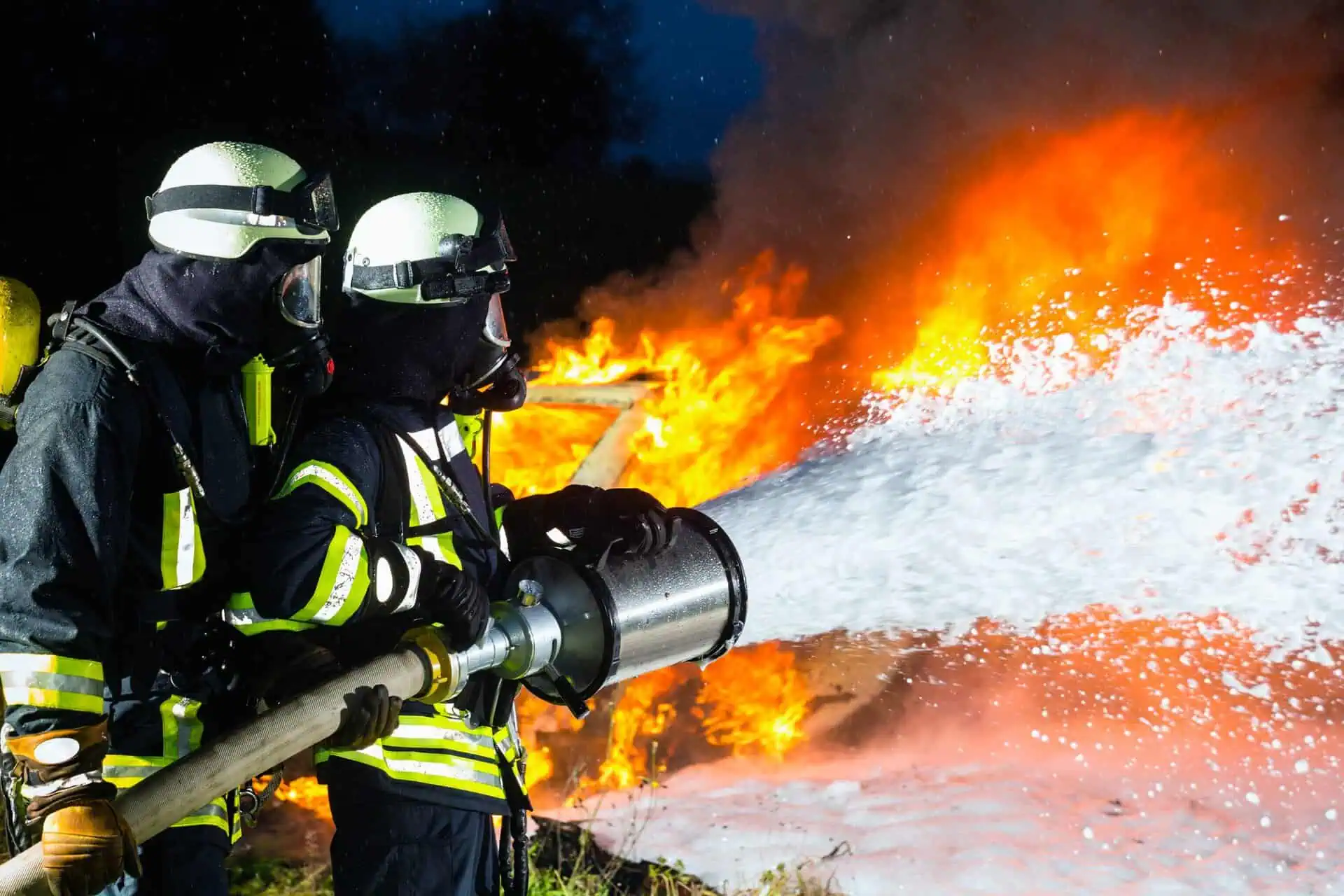AFFF Leukemia Lawsuit
- Last Updated: June 12th, 2025

Attorney Jessica Paluch-Hoerman, founder of TruLaw, has over 28 years of experience as a personal injury and mass tort attorney, and previously worked as an international tax attorney at Deloitte. Jessie collaborates with attorneys nationwide — enabling her to share reliable, up-to-date legal information with our readers.
Legally Reviewed
This article has been written and reviewed for legal accuracy and clarity by the team of writers and legal experts at TruLaw and is as accurate as possible. This content should not be taken as legal advice from an attorney. If you would like to learn more about our owner and experienced injury lawyer, Jessie Paluch, you can do so here.
Fact-Checked
TruLaw does everything possible to make sure the information in this article is up to date and accurate. If you need specific legal advice about your case, contact us by using the chat on the bottom of this page. This article should not be taken as advice from an attorney.
Key takeaways:
- The lawsuits allege that exposure to AFFF, which contains toxic substances like PFOA and PFOS, has led to health issues such as leukemia, prompting legal claims for compensation.
- The litigation has grown to encompass thousands of cases, including personal injury and water contamination claims, with a focus on the health impact of AFFF on firefighters and affected communities.
- The AFFF MDL is working toward resolving personal injury claims, with a tiered system proposed for compensating victims based on exposure and severity of health conditions.
Overview of the AFFF Leukemia Lawsuit
On this page, we’ll discuss an overview of the AFFF Leukemia Lawsuit, potential AFFF lawsuit settlement amounts, who qualifies to file an AFFF lawsuit, and much more.
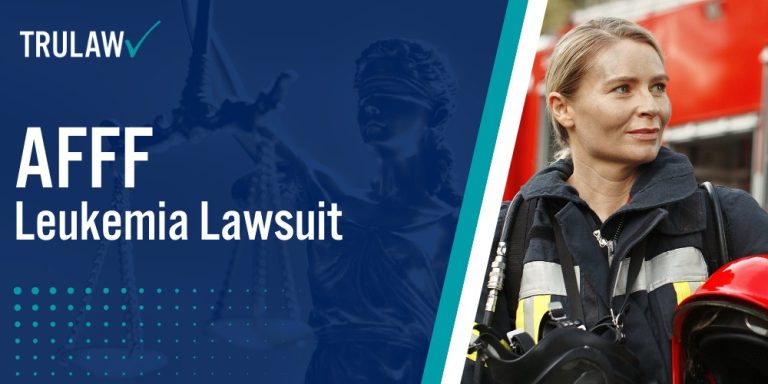
Intro to the AFFF Leukemia Lawsuits
Since their introduction in the 1960s, Aqueous Film Forming Foam (AFFF) has been used across various industries to suppress fires fueled by flammable liquids or gases.
While AFFF has proven effective in firefighting, it contains PFAS chemicals, often referred to as “forever chemicals,” which have been linked to several health risks, including leukemia, thyroid cancer, and other forms of cancer.
As concerns over AFFF exposure grow, lawsuits are being filed nationwide by individuals who have been diagnosed with cancer or other health conditions potentially related to this toxic foam.
If you or a loved one have been diagnosed with leukemia, another type of cancer, or a related health issue following exposure to AFFF, you may be eligible to pursue legal action.
The AFFF firefighting foam lawyers at TruLaw and our partner law firms are here to guide those affected through the legal process.
You can use the chatbot on this page to instantly check if you may qualify to file an AFFF lawsuit.
If you have any questions or wish to learn more about your potential claim, we are here to provide support and help you understand your options moving forward.
Table of Contents
PFAS Exposure from Firefighting Foam and Its Link to Leukemia
Exposure to PFAS chemicals has been associated with a heightened risk of developing leukemia.
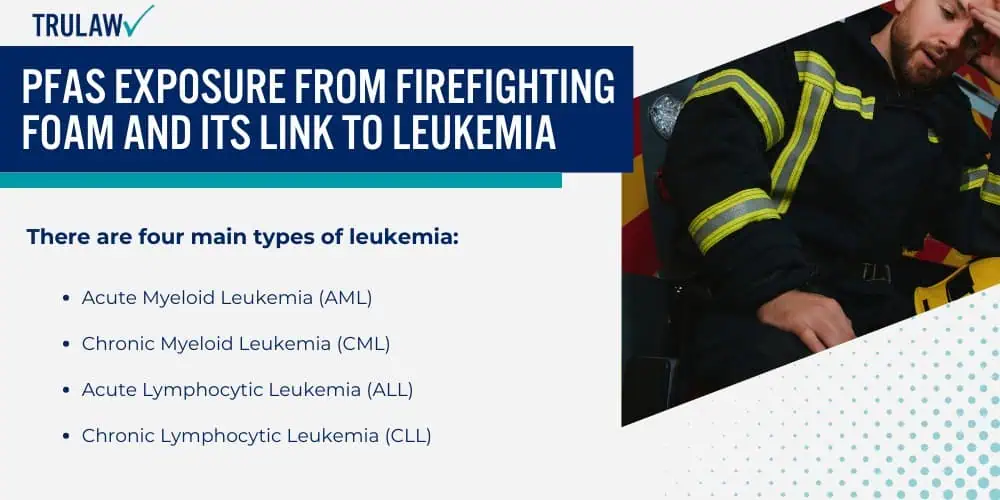
According to the National Cancer Institute, studies indicate that PFAS exposure may contribute to an increased cancer risk, including leukemia.
Additional research has supported these findings, suggesting that individuals exposed to PFAS could be at higher risk for certain cancers.
Leukemia is a cancer that impacts the blood-forming tissues of the body, particularly the bone marrow and lymphatic system.
There are four main types of leukemia:
- Acute myeloid leukemia (AML)
- Chronic myeloid leukemia (CML)
- Acute lymphocytic leukemia (ALL)
- Chronic lymphocytic leukemia (CLL)
The symptoms of leukemia can vary but often include:
- Fever or chills
- Persistent fatigue or weakness
- Tiny red spots on the skin (petechiae)
- Frequent or severe infections
- Unexplained weight loss
- Swollen lymph nodes, enlarged liver or spleen
- Easy bruising or bleeding
- Recurrent nosebleeds
- Excessive night sweating
- Bone pain or tenderness
Ongoing Research on PFAS Chemicals and Their Cancer Risk
Research has shown that specific PFAS chemicals, such as PFOA and PFOS, are linked to increased cancer risks.
- International Agency for Research on Cancer (IARC): Classified PFOA as a possible carcinogen and PFOS as possibly carcinogenic to humans.
- U.S. Environmental Protection Agency (EPA): Issued a health advisory for PFOA and PFOS, warning that long-term exposure to elevated levels of these chemicals could pose serious health risks.
- Journal of the American Medical Association: Reported a statistical association between PFOA exposure and increased risks of kidney cancer, testicular cancer, and ulcerative colitis.
- International Journal of Cancer: Highlighted a positive connection between PFOS exposure and breast cancer.
While research is ongoing, the evidence linking PFAS exposure to cancer is alarming, and continued studies are necessary to better understand the full extent of health impacts associated with these chemicals.
Firefighting Foam Cancer Lawsuits
Several companies are now facing lawsuits for the inclusion of toxic chemicals in AFFF Firefighting Foam products, which have been linked to cancer and other severe health issues.
Many firefighting foam products contain PFAS chemicals, commonly referred to as “forever chemicals,” due to their persistence in the environment and the human body.
Both the Centers for Disease Control and Prevention (CDC) and the Environmental Protection Agency (EPA) have issued warnings about the dangers of PFAS chemicals in AFFF, highlighting that exposure may contribute to a variety of serious health risks.
PFAS chemicals do not break down over time, remaining in the body and in the environment for extended periods.
This exposure has been linked to an increased risk of several cancers, including bladder, prostate, testicular, and kidney cancer, among other health issues.
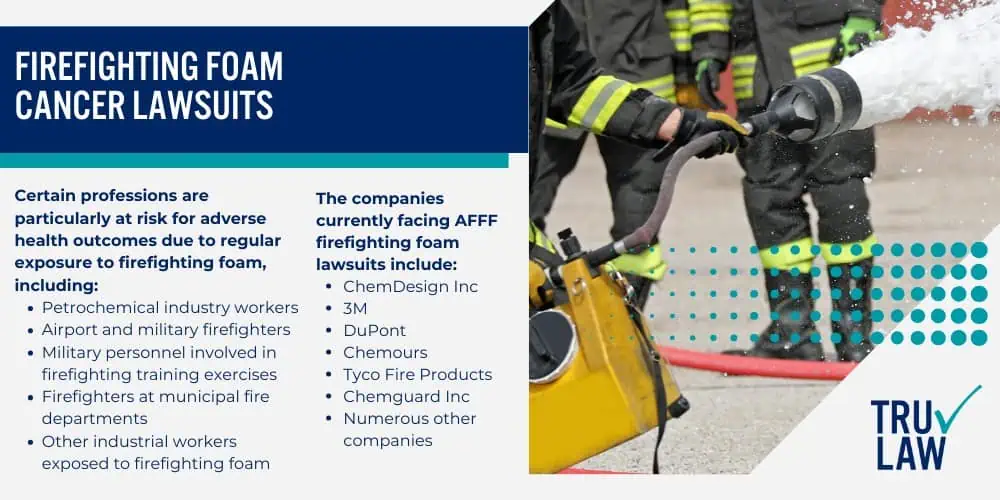
Certain professions are particularly at risk for adverse health outcomes due to regular exposure to firefighting foam, including:
- Petrochemical industry workers
- Airport and military firefighters
- Military personnel involved in firefighting training exercises
- Firefighters at municipal fire departments
- Other industrial workers exposed to firefighting foam
The companies currently facing AFFF firefighting foam lawsuits include:
- ChemDesign Inc
- 3M
- DuPont
- Chemours
- Tyco Fire Products
- Chemguard Inc
- Numerous other companies
Latest Updates on AFFF Firefighting Foam Lawsuits
Firefighting foam lawsuits are being handled through multidistrict litigation (MDL), with over 4,000 individual AFFF lawsuits currently pending.
While manufacturers of AFFF have made multiple attempts to dismiss these claims, TruLaw remains committed to pursuing justice for those affected.
The AFFF lawyers at TruLaw and our partner law firms are here to help individuals explore their legal options if they have been affected by AFFF firefighting foam exposure.
Use the chat on this page for an instant case evaluation to determine if you qualify to file an AFFF lawsuit today.
Potential Settlement Amounts in Firefighting Foam Lawsuits
It is still too early to determine the exact settlement amounts for AFFF lawsuits.
However, based on previous lawsuits involving PFAS contamination, estimates suggest that AFFF settlements could range between $20,000 and $600,000 (or more).
These figures are based on prior mass tort cases and are not guarantees of compensation in the AFFF litigation.
As the AFFF lawsuits continue to progress, more information will emerge, we will have a clearer understanding of potential AFFF lawsuit settlement amounts.
AFFF Firefighting Foam Contamination in Groundwater and Drinking Water
The environmental impact of AFFF firefighting foam has been wide-spread, particularly in terms of water contamination.
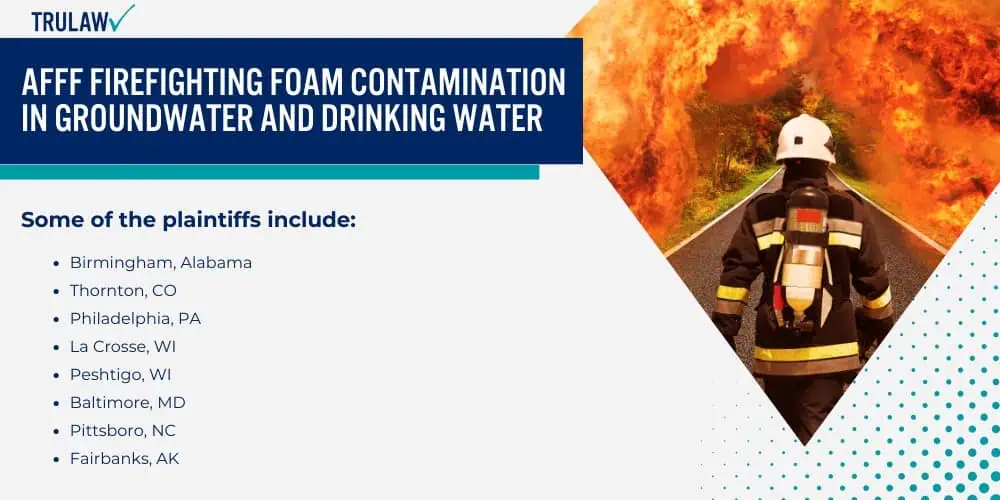
AFFF is considered the leading contributor to PFAS contamination in drinking water.
Because PFAS chemicals are highly soluble, they spread easily through water sources, contaminating groundwater, drinking water, and surrounding ecosystems.
Firefighting foam, used in large quantities to suppress dangerous fires, can often seep into the environment, contributing to widespread pollution.
In response to the environmental harm caused by AFFF, several state and local governments, as well as municipal water authorities, have filed lawsuits against AFFF manufacturers.
These lawsuits seek to address the contamination of water supplies and hold manufacturers accountable for the resulting damage.
Some of the plaintiffs include:
- Birmingham, Alabama
- Thornton, CO
- Philadelphia, PA
- La Crosse, WI
- Peshtigo, WI
- Baltimore, MD
- Pittsboro, NC
- Fairbanks, AK
- The Water Replenishment District of Southern California
- The Commonwealth of Massachusetts
- State of Michigan
- State of New Hampshire
- State of Ohio
- State of Vermont
Many other cities and local water agencies have also joined the legal efforts, seeking to mitigate the environmental damage caused by AFFF and ensure safe, clean drinking water for their communities.
It’s important to note that TruLaw is only accepting clients with AFFF personal injury lawsuits — we are not accepting clients for the AFFF municipal water contamination lawsuits.
How to File an AFFF Leukemia Lawsuit
If you or a loved one were exposed to PFAS chemicals from AFFF firefighting foam and later diagnosed with leukemia or other health issues, you may be eligible to seek compensation through an AFFF lawsuit.
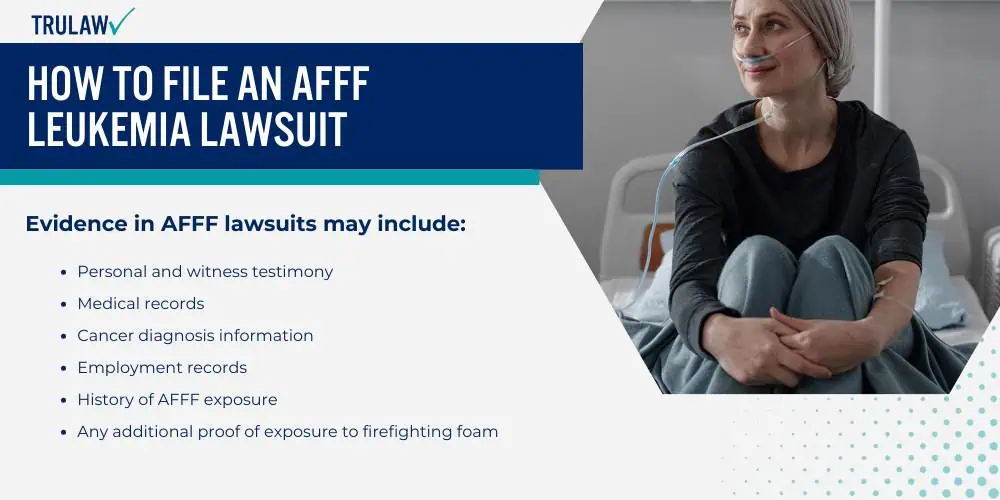
Reach out to us for a free consultation today to discuss the specifics of your case with our team and see if you are eligible for the AFFF lawsuit.
Use the chatbot on this page to instantly determine if you qualify for an AFFF firefighting foam lawsuit.
Collecting Evidence for AFFF Lawsuits
Having strong evidence is important in any AFFF lawsuit.
The AFFF lawyers at TruLaw and our partner law firms will assist you in gathering the necessary documentation to support your claim.
Evidence in AFFF lawsuits may include:
- Personal and witness testimony
- Medical records
- Cancer diagnosis information
- Employment records
- History of AFFF exposure
- Any additional proof of exposure to firefighting foam
Compensation for Damages in Firefighting Foam Lawsuits
Assessing damages is an important step in determining the compensation owed in an AFFF lawsuit.
These damages encompass both economic and non-economic losses suffered due to AFFF exposure.
The AFFF attorneys at TruLaw and our partner law firms will work closely with you to calculate the full scope of your damages and demand appropriate compensation from the responsible parties.
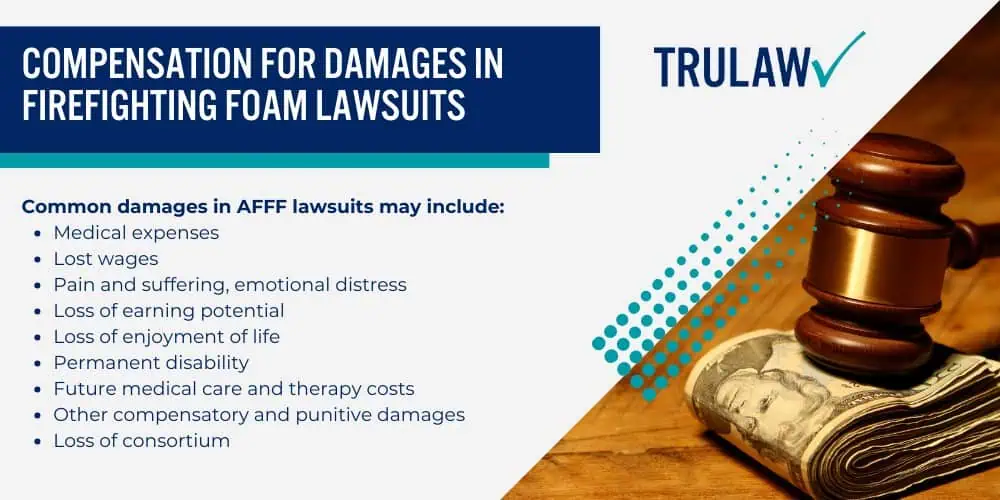
Common damages in AFFF lawsuits may include:
- Medical expenses
- Lost wages
- Pain and suffering, emotional distress
- Loss of earning potential
- Loss of enjoyment of life
- Permanent disability
- Future medical care and therapy costs
- Other compensatory and punitive damages
- Loss of consortium
Importance of Hiring Experienced Firefighting Foam Attorneys for Your Claim
It’s important to work with attorneys who have experience handling cases related to toxic exposure and product liability.
The firefighting foam attorneys at TruLaw and our partner law firms have vast experience handling AFFF claims and are dedicated to guiding clients through the process.
We recognize that AFFF exposure can lead to life-altering medical conditions, including cancer, which deeply impact a person’s quality of life.
That’s why we are committed to supporting our clients’ best interests and ensuring that they receive the compensation they deserve for the health consequences they have faced.
Any law firm you choose for your AFFF claim should demonstrate a strong commitment to securing fair compensation.
Carefully consider your options when selecting a legal team to handle your case.
TruLaw: Your Firefighting Foam Cancer Law Firm
TruLaw is actively assisting individuals explore their legal options if they have been impacted by Aqueous Film Forming Foam (AFFF) exposure.
Our focus is on ensuring that large corporations and chemical manufacturers are held accountable for the harm caused by the toxic firefighting foam they produced.
Many individuals who have been exposed to AFFF are seeking compensation for the health issues that have developed as a result of these products.
If you or a loved one have been diagnosed with cancer or experienced other health problems after consistent exposure to firefighting foam, you may be eligible to file an AFFF lawsuit.
Use the chat on this page for an instant case evaluation to determine if you qualify to file an AFFF cancer lawsuit today.
AFFF Lawsuit Frequently Asked Questions
-
What are PFAS chemicals?
PFAS (Per- and Polyfluoroalkyl Substances) are a group of human-made chemicals widely used across industries due to their resistance to heat, water, oil, and stains.
These unique properties have made PFAS a staple in products ranging from firefighting foam to non-stick cookware.
PFAS are toxic, persistent chemicals that do not break down easily in the environment.
Over time, they can accumulate in the human body, potentially leading to serious health effects, such as cancer, birth defects, and other complications.
Increased awareness of their risks has led to bans and restrictions in several states and countries globally.
-
What is Aqueous Film Forming Foam (AFFF)?
Aqueous Film Forming Foam (AFFF) is a type of firefighting foam commonly used in industries such as aviation, military, and petrochemical for fire suppression.
AFFF works by creating a barrier between the fire and the oxygen, which smothers and extinguishes fuel-based fires.
Developed in the 1960s by companies like 3M, Chemguard, and Tyco Fire Products, AFFF has been a key tool in extinguishing jet fuel fires, especially on military bases and airports.
-
What products are PFAS chemicals in?
PFAS chemicals are not limited to firefighting foam — they are found in many everyday products due to their durable, water-resistant properties.
These products include:
- Nonstick cookware
- Personal care products, such as shampoos and cosmetics
- Stain-resistant coatings for carpets and upholstery
- Plastic wrappers and packaging
- Microwave popcorn bags
- Cleaning products
- Water-resistant fabrics like rain jackets and tents
- Grease-resistant paper
-
Who is at risk for exposure to firefighting foam?
Those most at risk for exposure to firefighting foam are individuals whose work duties regularly involve the use or handling of AFFF products.
Exposure can also occur through contaminated drinking water, especially in areas near fire training facilities.
People most likely to suffer occupational exposure include:
- Employees of AFFF manufacturers
- Airport and military firefighters
- Municipal firefighters
- Workers in oil refineries and similar industrial facilities
- Individuals working on flight decks
- Workers involved in transporting or disposing of AFFF foam
-
What health problems may AFFF firefighting foam be linked to?
Exposure to PFAS chemicals in firefighting foam has been associated with a range of serious health conditions.
These potential health risks include, but are not limited to:
- Bladder cancer
- Breast cancer
- Colon cancer
- Colorectal cancer
- Endometrial cancer
- Kidney cancer
- Leukemia
- Liver cancer
- Lymphoma
- Mesothelioma
- Multiple Myeloma
- Non-Hodgkin Lymphoma
- Ovarian cancer
- Pancreatic cancer
- Prostate cancer
- Rectal cancer
- Testicular cancer
- Thyroid cancer
- Thyroid disease
- Ulcerative Colitis
- Birth defects and other reproductive issues
- Developmental problems
- Heart disease
- Hormonal imbalances
- Immune system disorders
- Liver damage
- Neuroendocrine tumors
- Reproductive issues
- Skin and eye irritation
- Other health complications
-
Who are the defendants in AFFF lawsuits?
The defendants in AFFF cancer lawsuits are companies that have manufactured or supplied firefighting foam to various industries, including fire departments, military bases, and airports.
Some of the companies named in AFFF lawsuits include:
- Tyco Fire Products
- 3M
- ChemDesign Inc.
- DuPont
- Chemours
- Chemguard Inc.
- Over a dozen other companies
-
What is the AFFF MDL?
The AFFF MDL (Multidistrict Litigation) was established in the US District Court for the District of South Carolina.
MDL is a special legal process used to consolidate cases that share common issues.
This consolidation speeds up the litigation process by grouping pretrial proceedings into a single court.
In the AFFF litigation, the AFFF firefighting foam MDL helps manage thousands of lawsuits related to firefighting foam exposure more efficiently.
-
How can firefighting foam lawyers help me?
AFFF Lawyers experienced in firefighting foam litigation can assist you through every stage of the legal process.
Some of the ways the AFFF firefighting foam lawyers at TruLaw and our partner law firms can support you include, but are not limited to:
- Collecting and organizing evidence for your AFFF lawsuit
- Evaluating the damages you have suffered due to firefighting foam exposure
- Identifying responsible parties and determining liability for your cancer diagnosis
- Providing guidance and answers to any legal questions you may have throughout the process
- Working diligently to pursue a potential settlement for your AFFF lawsuit
-
How much does it cost to hire a firefighting foam attorney?
The experienced firefighting foam attorneys at TruLaw and our partner law firms operate on a contingency fee basis, meaning there are no upfront legal fees for pursuing your firefighting foam lawsuit.
If no settlement or compensation is awarded, you won’t owe any legal fees.
This contingency structure ensures that you can move forward with your case without financial risk on your end.
It’s important to note that TruLaw is only accepting clients with AFFF personal injury cases — we are not accepting clients for the AFFF municipal water contamination lawsuits.

Managing Attorney & Owner
With over 25 years of legal experience, Jessica Paluch-Hoerman is an Illinois lawyer, a CPA, and a mother of three. She spent the first decade of her career working as an international tax attorney at Deloitte.
In 2009, Jessie co-founded her own law firm with her husband – which has scaled to over 30 employees since its conception.
In 2016, Jessie founded TruLaw, which allows her to collaborate with attorneys and legal experts across the United States on a daily basis. This hypervaluable network of experts is what enables her to share the most reliable, accurate, and up-to-date legal information with our readers!
Additional AFFF Lawsuit resources on our website:
Here, at TruLaw, we’re committed to helping victims get the justice they deserve.
Alongside our partner law firms, we have successfully collected over $3 Billion in verdicts and settlements on behalf of injured individuals.
Would you like our help?
At TruLaw, we fiercely combat corporations that endanger individuals’ well-being. If you’ve suffered injuries and believe these well-funded entities should be held accountable, we’re here for you.
With TruLaw, you gain access to successful and seasoned lawyers who maximize your chances of success. Our lawyers invest in you—they do not receive a dime until your lawsuit reaches a successful resolution!
AFFF Lawsuit claims are being filed against manufacturers of aqueous film-forming foam (AFFF), commonly used in firefighting.
Claims allege that companies such as 3M, DuPont, and Tyco Fire Products failed to adequately warn users about the potential dangers of AFFF exposure — including increased risks of various cancers and diseases.
Depo Provera Lawsuit claims are being filed by individuals who allege they developed meningioma (a type of brain tumor) after receiving Depo-Provera birth control injections.
A 2024 study found that women using Depo-Provera for at least 1 year are five times more likely to develop meningioma brain tumors compared to those not using the drug.
Suboxone Tooth Decay Lawsuit claims are being filed against Indivior, the manufacturer of Suboxone, a medication used to treat opioid addiction.
Claims allege that Indivior failed to adequately warn users about the potential dangers of severe tooth decay and dental injuries associated with Suboxone’s sublingual film version.
Social Media Harm Lawsuits are being filed against social media companies for allegedly causing mental health issues in children and teens.
Claims allege that companies like Meta, Google, ByteDance, and Snap designed addictive platforms that led to anxiety, depression, and other mental health issues without adequately warning users or parents.
Transvaginal Mesh Lawsuits are being filed against manufacturers of transvaginal mesh products used to treat pelvic organ prolapse (POP) and stress urinary incontinence (SUI).
Claims allege that companies like Ethicon, C.R. Bard, and Boston Scientific failed to adequately warn about potential dangers — including erosion, pain, and infection.
Bair Hugger Warming Blanket Lawsuits involve claims against 3M — alleging their surgical warming blankets caused severe infections and complications (particularly in hip and knee replacement surgeries).
Plaintiffs claim 3M failed to warn about potential risks — despite knowing about increased risk of deep joint infections since 2011.
Baby Formula NEC Lawsuit claims are being filed against manufacturers of cow’s milk-based baby formula products.
Claims allege that companies like Abbott Laboratories (Similac) and Mead Johnson & Company (Enfamil) failed to warn about the increased risk of necrotizing enterocolitis (NEC) in premature infants.
Here, at TruLaw, we’re committed to helping victims get the justice they deserve.
Alongside our partner law firms, we have successfully collected over $3 Billion in verdicts and settlements on behalf of injured individuals.
Would you like our help?
